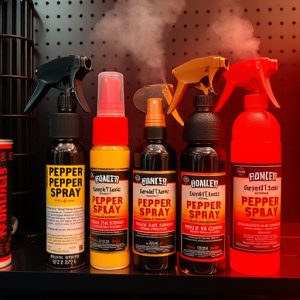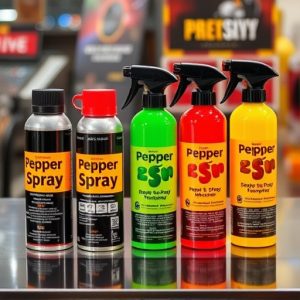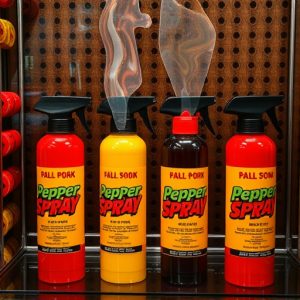Harnessing Pepper Spray Display Technology for Enhanced Wildfire Management
Pepper spray displays serve as non-lethal deterrents in law enforcement and personal defense, offer…….
Pepper spray displays serve as non-lethal deterrents in law enforcement and personal defense, offering advanced features like adjustable spray patterns, laser sights, and UV marking dyes. Users must be well-versed in the technical specifications, including range, ingredient concentration, and delivery system type (foam, gel, or traditional spray), to use them effectively and safely. High-quality pepper spray displays include safety features to prevent accidental discharges and protect bystanders from exposure. They must comply with legal standards and certifications for reliability in critical situations. In firefighting, these displays have emerged as a game-changer, particularly in regions with scarce water resources or where water usage could cause damage. Pepper spray displays interrupt the combustion process, reducing fire intensity and slowing its spread, allowing firefighters to maintain a safer distance. Their role in wildfire management is also crucial for safeguarding communities and critical infrastructure, as well as for protecting natural habitats by deterring wildlife from starting or spreading fires. However, the ethical implications and long-term effects of repeated exposure on animals must be carefully considered when integrating this technology into conservation efforts. The balance between effectiveness and ethical use is key to preserving both ecosystems and wildlife through these pepper spray displays.
When wildfires rage, firefighters face a formidable challenge. In this article, we delve into the innovative role of pepper spray display technologies in enhancing firefighting efforts and public safety during such crises. Our exploration covers the intricacies of these advanced systems, their practical application in combating wildfires, and the evaluations of their effectiveness and ethical implications within the broader context of wildfire management. Join us as we shed light on how pepper spray displays can be a game-changer in this critical field.
Understanding Pepper Spray Display Technologies: A Comprehensive Guide
Pepper spray displays serve as a critical tool for law enforcement and personal defense, offering a non-lethal means to incapacitate an assailant. These advanced systems are designed to project a powerful stream or cloud of pepper spray at a considerable distance, effectively deterring aggressors and providing precious time for escape or further action by authorities. The technology behind pepper spray displays has evolved significantly, incorporating features such as adjustable spray patterns, laser sights for aiming accuracy, and UV marking dyes to aid in suspect identification post-application. Understanding the mechanics and capabilities of these systems is essential for users to utilize them effectively and safely.
When selecting a pepper spray display, it’s important to consider factors such as spray range, concentration of the active ingredient, and the type of delivery system—be it a foam, gel, or traditional spray. High-quality displays often come with safety features like a locking mechanism to prevent accidental discharges and integrated safeguards that ensure the spray is directed away from vulnerable areas, such as the eyes of bystanders or wind directions. Additionally, these devices undergo rigorous testing to comply with legal standards and certifications, ensuring they function as intended when most needed. Users should familiarize themselves with these technologies to harness their full potential in various self-defense scenarios.
The Role of Wildfire Pepper Spray in Firefighting Efforts and Public Safety
Wildfire pepper spray represents a significant innovation in firefighting arsenals, offering enhanced protection for both firefighters and the public. Unlike traditional water-based methods, this non-toxic, organic compound can be deployed as part of firefighting efforts to suppress flames where water is scarce or would cause undue damage. The pepper spray acts by disrupting the combustion process, effectively reducing the intensity of the fire and slowing its spread. This not only aids in managing the immediate threat but also prevents potential escalation, which can be critical in volatile conditions. For firefighters on the front lines, the use of pepper spray displays reduces the risk of injury from flames or heat exposure, as it allows them to operate at a safer distance. It is particularly effective in protecting critical infrastructure and communities at risk during wildfire events, ensuring public safety by safeguarding lives and property. The integration of these pepper spray systems into firefighting strategies underscores their role as a versatile and critical tool in modern fire suppression tactics.
Evaluating the Effectiveness and Ethical Considerations of Pepper Spray Displays in Wildfire Management
In the realm of wildfire management, the deployment of pepper spray displays has emerged as a potentially effective tool to protect natural habitats and reduce the spread of wildfires. These devices are engineered to release a non-lethal irritant that deters wildlife from approaching or igniting combustible materials, thereby preventing the ignition or propagation of fires in sensitive ecosystems. The effectiveness of pepper spray displays is contingent upon precise placement and timing; they must be strategically distributed along potential fire lines to deter animals such as bears or elephants that might otherwise inadvertently contribute to fire spread by seeking out termite nests, a known cause for wildfires in certain regions.
While the use of pepper spray displays for fire prevention is an innovative approach, it raises ethical considerations. It is crucial to assess the potential impact on wildlife, ensuring that these measures do not compromise the safety or well-being of animals. The ethical deployment involves understanding animal behavior patterns and the environmental context in which these devices are used. Moreover, the long-term effects of repeated exposure to pepper spray should be carefully monitored to prevent adverse consequences for wildlife. Balancing effectiveness with ethical responsibility is key; the goal is to safeguard both natural habitats and their inhabitants through judicious application of technology in wildfire management strategies.


